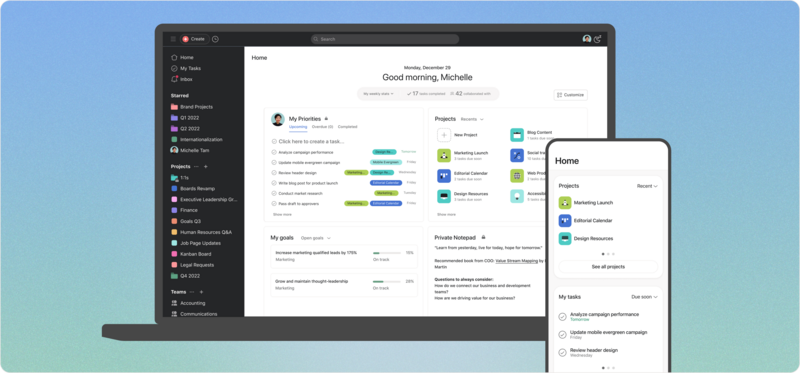
Wondering what is Asana? Then you have come to the right place.
Asana is a task and work management platform crafted to enhance productivity, oversee project-related tasks, store documents, and foster collaboration, whether asynchronously or in real-time.
If Asana has caught your attention, chances are you're pondering over several questions before incorporating it into your workflow. Keep reading to delve deeper into Asana's features and determine if it’s a good fit for you.
What Is Asana?

Asana shares similarities with other task and project management software, providing teams with the tools to organize, collaborate, plan, and execute tasks efficiently. It serves as a reliable ally in navigating through chaos and meeting deadlines effectively.
Functioning as a web-based task management and collaboration platform, Asana tackles the clutter of emails by centralizing all tasks. Teams leverage Asana to monitor tasks, engage in seamless collaboration with colleagues, share relevant files, and more.
Renowned companies like Deloitte, Airbnb, Pinterest, and Dropbox have embraced Asana for its plethora of project management and collaboration features.
With millions of users across 195 countries and ongoing global expansion, Asana has become a go-to choice for industry giants and individuals alike.
If you are looking for other websites like Asana, please read our post on Asana Alternatives.
3 Asana Core Features
Here are three main features of Asana.
Time Tracking

While there are a few alternatives on the market offering native time tracking, Asana’s built-in time tracking feature surpasses its counterparts in thoroughness.
Users on paid plans can effortlessly track time for individual tasks using a stopwatch-style feature embedded within each task card, creating a detailed log of time spent per task.
Furthermore, users can concurrently track multiple time cards, monitor team workloads comprehensively, and leverage time tracking trends to automatically forecast time estimates for new projects.
Project Portfolios
Unlike some platforms struggling to consolidate statistics across multiple projects, Asana empowers users to excel in multi-project management through a streamlined portfolio interface.
Quick-view options enable users to assess the status of vital initiatives with ease, providing access to more in-depth information as needed.
Additionally, users can access streamlined reporting and analytics to gain a rapid overview of budgetary information, time tracking data, and more across various projects.
Goal Management
Beyond aiding in task and project management, Asana enables teams to establish goals complete with assigned owners, deadlines, and predefined parameters for measuring progress and success.
These goals can be linked to departmental objectives, company-wide aspirations, or segmented into smaller sub-goals for clarity.
Furthermore, automation tools facilitate automatic progress updates for team members and managers at predetermined intervals, ensuring everyone stays informed about goal progression.
Asana for Project Management: Pros and Cons
The following are the pros & cons of Asana.
Asana Pros
1. Asana boasts an attractive interface design, enhancing user experience.
2. The calendar feature is seamlessly integrated with all tasks, providing easy access and organization.
3. Users have the ability to view personal tasks conveniently in one centralized location.
4. Email integration streamlines communication and task management processes.
Asana Cons
1. Asana lacks a straightforward method to track all items across multiple projects that have the same due date or week.
2. Due to its predominantly text-based nature, structural issues, task removals, or name changes may occur frequently.
3. Assigning multiple people to the same task is not supported, limiting collaboration options.
4. As the number of tasks increases, performance may slow down, impacting overall efficiency.
5. Asana does not include built-in time-tracking capabilities, necessitating the use of external time-tracking software.
Conclusion: What is Asana
In conclusion, Asana is more than just a task management tool; it's a powerful platform that empowers teams to work smarter and achieve their goals.
With its intuitive interface, robust features, and endless customization options, Asana is the ultimate solution for streamlining workflows, fostering collaboration, and maximizing productivity.
Whether you're a small startup or a large enterprise, Asana has everything you need to succeed in today's fast-paced world.
So why wait? Start your Asana journey today and take your productivity to new heights.

